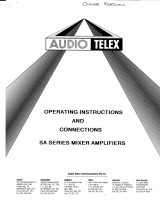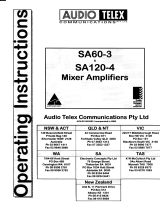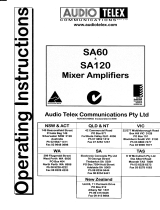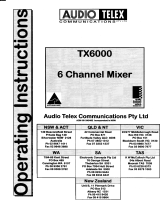Page is loading ...

AMtilDilril@
ti
m
co M lvt
u N
I
cATl o N sPrY
LrD
g
o
-
a
tr
c
-
o
=
l-
(u
l-
o
AT12OR
Receiver
Amplifier
&
ATl2ORC
Receiver
Cassette Ampl ifier
A
3
Od t
El&rrd
g
Audio Telex
Communications
Pty
Ltd
ACN 001345482 lncorporat€d ln NSW
NSW & ACT
QLD
& NT
1 49 Beaconsfleld
Stre€t
Prlvate Bag 149
Slherwater NSW 2128
Australla
Ph 02 9647
1411
Fax 02 9648 3698
42 Commerclal Road
PO
Box
871
Fortltude Vall€y
QLD
4006
Ph 07 3852 1312
Fax Ol 32521237
2U 27 7 ]llddleborou
gh
Road
Box
HllMc 3128
PO Box 151
Blackbum South VIC
3130
Ph 03 9890 7477
Fax 03 9890 7977
7164-66 K€nt Street
PO
Box
489
Cannlngton WA 6107
Ph 08 9356 2761
Fax 08 9356 2762
Electronic Concepts Pty Ltd
76 George Street
Thebarton SA 5031
PO
Box
7034 Hutt Street
Adelelde SA 5000
Ph 08 8234 9411
Fax
08 8234 9441
K W tlcculloch Pty Ltd
'
5lla Albert Road
lf,oonah TAS 7009
Ph 03 6228 6373
Fax 03 6278
'1063
NewZealand
Unlt B,
'l
l Plermark Orlve
PO 8ox 5'12
Albany Nz 1331
Ph 09 415 9426
Fax 09 415 9864

AT120R-1
Receiver
Amplifier
ATI 20RC-l
Receiver/Cassette
Amplifier
Product
Description
The ATl20R-l
is a 120
watt, 4
channel
(dual
mic/line) mixer
amplifier
that has
been optioned with
ur AIvl/FM radio
receiver.
Sfunilarly,
the ATl2oRC-l
is optioned
with
an Alvl/FM radio
receiver
and cass€tte
player.
The AT120R-I
and ATl20RC-l
o,p€rate
from
240 VAC,
50
tIz
(or
110
VAC with
hctory
modification)
and may be desk
or
rack
mounted
(via
an optional rack
mount kit).
Both the AT120R-1
and
AT120RC-1
will deliver
120 watts into
loads of4 or 8
obms, 70 m 100
volt line. Both
amplifiers include
a
6 zone, 100
volt line
spea.ker zone
select f$tur€
cmplete with
all-call. The maximum
recornmended
load
of the ATt20R-l
and
ATI20RC-1
on
the 100 volt
line output is
80 ohms.
Front Panel
Controls
Dual
ilicrophonerline
Gain:
fne
4 dual midline
input
controls are labelled
chl
.... Ch4 and should be
adjusted
to
provide
the required
mix
level for
each individual
channel. Start
with
the conhols set to
Level 0 and
turn the controls
clockwise
until the
desired mix level
for
each channel is reached.
Bass
Tonal
Control: Setting
this control
in the c€ntre
position
will
give
an overall
flat bass response
to the output
of the
amplifier.
Adjusting the
bass control in
a clockwise
direction will
provide
up to 12
dB of bass
boost
@
lW Hz. Adjustin!
the
bass
control in
a count€r-clockwise
direction will
provide
up to 12
dB ofbass
cut
@
100 IIz.
Treble
Tonal Control:
Setting this
control in
the cenne
position
will
give
an overall flat h€ble response
to the
output of the
amplifier.
Adjusting
the treble
c.onhol in
a clockwise
direclion will
provide
up to l0
dB of aeble
boost
@
l}K Ih.
Adjusting
the
treble
control in
a counter-clockwise
direction
will
provide
up to l0
dB ofheble cut
@
lOK liz.
llaster
Output
This
confiols
the ov€rall
output l€vel
ofthe amplifio
depending
or the levels
set for the individual
inpgt
mix
channels as
detailed above. Start with
the control
set to Leyel
0 and turn
clockwise until
the desired
output level
of the amilifier
is
reached
All Call Button:
When
pressed
this
grey
button
will connect
the 100 volt
output of the
amplifier ro
all 6 of the switched
outputs
of the amplifier. Depressing
this button
again will
disconnect the
switched
output. This switch is
push-on,
push-off
and is
nm int€docking.
Speaker
Selector: These 6 black
buttons
are for switching
the 100 volt
line output
of the amplifier
to
any
combination
of
the
6 available
speaker zmes.
The switches
are
push-on,
push-off
and are non int€docking
(both
with
cach other and with
the
all-
call
button). The maximum
capacity
of each speaker
zone is
60 watts so care
should be taken to ensure
that no individual
zones
is
loaded
dovn for more than 60 watts,
alwals remembering
that the total amplifier
load is 120 watts.
It is
possible
to safely have
one
zone
set for 60 watts
and the
other 5 zones s€t for
12 watts for
o(ample.
Limit
Led: This red led is
designed
to
give
the user an indication
of the operating
conditior
of the amplifier
urd
is
integral
to
the inbuilt
proteclion
included
in the amplifier.
This
led will
glow
red
ifthe amplifer
is o,perating
into an
q(cessive
lood or if
one or
more ofthe input
channels is
zupplying an
unacceptably
high level
of signal. It
is nonnal for this
ledto flicker
ol and offhowever,
if
it
glows
steady, the amplifier
will shut
dorvn for
a
period
of approximately
3 seconds
and continue to
cycle in this frshion
until
the
abnormal
condition is removed-
Evac BU$On: When
pressed,
this
orangg
push-on,
push-off
button will
activate
the
inbuilt
evacuation
tone
gencrator.
when
the tone is
acti te4 input
channels 3
& 4 are
muted wiile input
channels
I & 2 remain active in
case an
em€rg€ncy message
is
required.
Bell Button: When pressed
this
black,
push-or,
push-offbutton
will
activate
the inbuilt bell tone
generator.
When
the tone
is
activate4 inputs
3 &
4
are muted
while inputs
I & 2 remain
active.
POWef Button:
This
switch
contols the
switching
of AC
power
to
the amplifier. Rocking
this
switch upwards tums
on AC
power
to the amplifier
while rocking
the
switch downwards
hrns
pow€f,
offto the
amplifier. When in
the upward on
position,
the
red
neon in
the body ofthe
switch will
gtow.

AmrFm Recelver: The
receiver includes
a
gain
control which
ap€rates identically
to the midline
gain
controls described
on
the previous page (although
it is cmpl€tely
indep€ndent
of the controls
describ€d above). The
gain
coahol incorpdated
in to the
receiver
controls
the input level to
the amplifi€r
for
both
the receiver
and the cass€tte
player (if
installed).
When installed
and
activated,
the cassette player
will
override the receiver
so that only one ofthe receiver
or cassette
player
may
b€ operat€d
at once, the
cassette
play€r
haying priority.
You
may monitor
the output
of the rec€iver
via
an
intemal monitor
speaker.
The
volume ofthe monitor
speaker
is contolled
by
the vertical
slider contol labelled
Monitor, located
cenhally on the fiont panel
ofthe amplifi€r.
Ifyou \mnt
to
preview
the output of
the
receiver
before sending it
out live to
the sp€akers,
simply turn
the amplifiers master
output level
control fiIly
anti-clockwise
to
turn
offthe output
ofthe
amplifier. Note
that ifyou
do this, all output
is tumed ofi, including
all micophone
inputs.
Five
hming bands
are availablg
2 x AM
and 3 x FM: the receivers
display
panel
will illuminate
to display
the relevant
information.
To select
the
desired band
press
the button marked
Alv{/FM. Each time
this button is
pressed
a different
tuning
band
will
be indicated
on the
display
panel.
Up to 30
preset
channels may
be stor€4 6 for each
tuning band. To
store a channel
operate
the up
and down
arrow buttons
tmtil
you
locate
and
are
properly
tuned to the radio
station of
your
choice. Then,
press
the memory
button
which will
cause the
channel to flash
on the
display
panel.
Press
the desired storage
channel
(numbered
i
to Oy. the
radio
station
chos€n is th€n
stored in
that mernory
location. You may
autornatically
search for radio
statiom by op€rating
the up
and down
arrow
buttons. The receiver
will
search fc
and automatically
lock on to
threshold signals in
the frequency band
you
have
selected.
Continue
to
press
the up or
donm arrow
buttons to resume
your
s€arch
or to fine tune
any station selected.
Cassette
Player
(AT120RC-1
Only): me cassette
player
has
3
mique
controls,
one each for Eject,
Rewind
(REw)
and Fast
Forward
@F).
In
addition, there
is
a
gain
contol located
on the receiver
module that
controls the
output level
of the
cassette
deck
(and,
when
a cassette is
insertod
has
pricity
over the receiver
as detailed
above). The cassettJ
phyer
may
be
mmitored
and
preyiewed
in exactly the
same fashion
as the receiver.
The
cassette
playef
will tregin
playing
imnediately
a cass€tte is ins€fted
though the slot in front
ofthe cassette
play€r.
The REW
and FF
buttons will
shuttle
the cassette backwards
or
forwards
respectively. Pressing
both
the REW and FF
buttors together
will
reverse
the
playing
direction
of the cassette player
and effectively
change the side
of the cassette
bcing
played.
Pressing
the
eject
button will
eject the cass€1te
and switch
back
to the receivers
output. Ifyou
do not want to
switch inmediately
back to thi receivers
output when you
eject
the cassefte,
make sure
that the
gain
conhol on
the
receiver
is
turned fully munter
clockwise.
Optional
Accessorles
E
The instrllrtion
of some
ofthe following
optional
rccessorics involves
scc$s
to tbc insidc
of thc rmplificr.
Inste[etion
should
only be tttemptcd
by a
qurlified
techniciln.
A.lways
turn ofi
thc
AC power
lnd remove the
AC
power
cord
bcfore
tttempting
to lccess
thc inside
of the
rmpllficr, Pless€
conbct
your
ne.rest Andlo Tclcr
ofncc for detrils of
your
nerrest
quelified
technicirn.
TX3010
Vox
tutlng ltodule.
Wherr installed
(as
per
the
comprehensive instructions
supplied with the TX3010),
channels
I & 2 of the
amplifier will
mute
channels
3 & 4 ofthe amplifier.
The receiver
and
cass€tte
player
inputs will
also
be
muted.
ATR
KBLK. 19" rack mount kit
Please
see ovsr
for rear
panel
connection
details 3

Rear Panel Connections
1.9 I !l
I c
, Lr lr l
@@@@
l.
3 Pin IEC AC tains Power lnlet
rhe operating voltage
is
240
VAC
@
50 llz t I l0 vAc
@
60 Hz. The
AC
power
voltage level is not ext€rnally us€r adjustable but is frctcy
pre-set.
The
inl€t is equipped widr an inbuilt AC fuse holder
fittd with a 4 Anp fuse
plus
a spare. Power consumption
is 225 YA.
t
Pbasc ensurc thlt the
mths
powcr
cord is
disconnccted
bcfore rttcmpting to check or rephce this fusc.
DlfeCt OUtpUt COnneCUOnS.
Th€s€ screw terminals allow access
lo the direct outputs of the amplifier
and
allow
for
the swirching ofthe
various
tmes available.
Reading frm left
to
right the terminals are:
Low Impedance Common
4
Ohms
8 Ohms
Costant
Voltage
Commdr
70
Volt Line
100 Volt Line
Spare
Bell
+
Evacuatim
+
Alert
+
Pre Annotmce
+
Tone Generatc Common
(note
that only
one
tme may be activated at a time)
Switched OUtpUtS.
feaaing from t€ft to right these screw terminal
pairs
ccrespod to the switched
1@ volt line outputs
6 .... 1 as indicated m the front
panel
of the arnplifier. For each
pair,
the left hand terminal is the cmmm
and the right hand
terminal is the 100 volt ontput.
Receiver Antenna Connection.
As described above, the
receiver can tune to both the AM and FM bands. The FM
band
has dual 75 and 300 ohn impedance capability. For best FM
r€sults, we recommend using the 75 ohm cornectiqr to a
rermote
antenna
via 75 olun cnaxial cable.
Tape Output
This
is a
monaural
RCA type connector and
witl
provide
an output of 350 mv in to a loK ohm
load.
This
output is sourced befor€ the
mastei
gain
contol and as such,
the tape output level is not influenced by the operation ofthe
master
gain
control.
Active
Balanced, XLR Sockets For The ticrophone
lnputs.
with
an
input sensitivity of 0.75mv
@
200
ohms. Pin oqmcctims are:
pin
#l-earth;
pin
#2-active
OiSh,
+);
pin
#3-ac-tive
ooq ).
Phantom
pow€r
of
+15
volts is
available on all
microphone inputs. Reading frm left to right across the rear
panel,
the cannectim are
for microphme inputs 4,
3,2,&lrespectively.
RCA
Sockets For The onaural Line Level lnputs.
Inputs
#'s 1,2
& 3
have an input s€nsitivity of 75mv
@
47K
ohns.
Input
il4
has an input sensitivity of250 mV
@
47K ohms. Reading
from left to right across the rear
panel,
the
connectiurs
are
fc inputs 4,
3,
2,
&
I respoctively.
3.
4.
5.
7.
/








